|
Winsham Wildlife Diary 2019
As I write this wildlife diary for 2019 I am staring out of the window
in January 2020 looking
at pouring rain and raging winds – storm Brendon.
It was much calmer this time last year.
An over-riding theme in 2019 has been climate change and the perilous
state of our wildlife.
Greta Thunberg and David Attenborough have dominated the headlines even pushing Brexit into
the background – no mean feat!
Certainly I have noticed a decline in certain insects and birds and some
mammals and invertebrates in our garden and the surrounding area.
But is that a trend or is it just on account of the weather in a
particular year?
Interestingly a programme on Radio 4 called ‘Costing the Earth’
broadcast two quotes from a former American president and a former British prime minister.
Here is George Bush in 1993 – “If we don’t look after the
earth, the earth won’t look after us.” And Margaret
Thatcher in 1980 (that is 40 years ago!) talking to the Royal
Society about carbon dioxide emissions said that climate change is the biggest challenge we have ever
faced.
As some of you know I was in hospital and out of circulation for all of
February and half of March.
When I returned home the birds were busy building nests and the
primroses were looking beautiful.
|
April
The blackthorn blossom has been very prolific this year but is going
over now on 18 April.
The flowering period can vary greatly from
year to year between February and April.
Our cotoneaster horizontalis is buzzing with bumble bees, honey bees and
wasps.
Sadly I can’t
identify many of the bumble bees but there is a good app
available to help me.
|
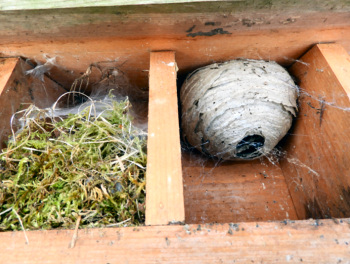
Wasps taking advantage of our nestbox |
May
I made a note that on 3rd May the following wild flowers were
in flower:
vetch, speedwell, bluebells (going over), stitchwort, violets, cow
parsley, campion, herb robert, comfrey, buttercup, daisy,
dandelion, cowslip, lady’s smock, pink clover and ramsons.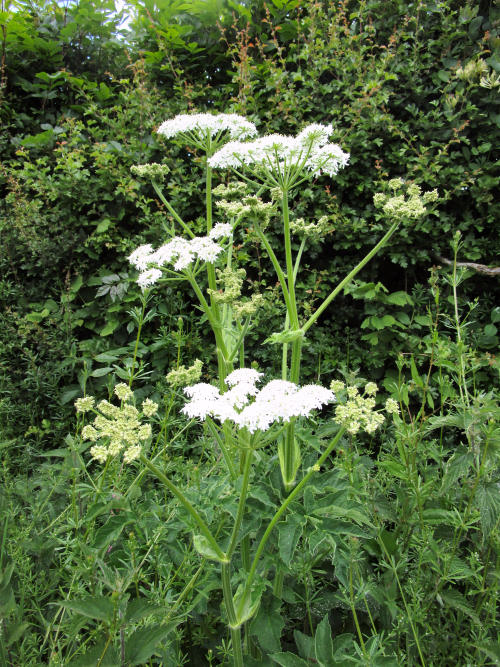
This is about the same timing as last year.
Clapton Village Hall held a Somerset Day on 11th May,
celebrating all things ‘Somerset’.
Our very own Brian Goodland was there with a honeycomb of
live bees and a very good display.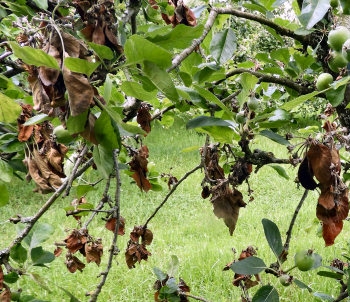
We are hearing a lot about rewilding and so I have left “weeds” to grow
in my border, chiefly campion and stitchwort. Soon there will
be oxeye daisies and foxgloves.
I am pleased with the result!
Hogweed is generally unloved but I have discovered why it
is called hogweed – pigs absolutely love it.
The end of May and we have not had a drop of rain for weeks.
Some of the apple trees in our orchard look
as though they are suffering
|
|
July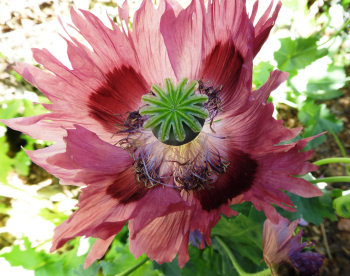
This young thrush, not long fledged, somehow got into the greenhouse.
It allowed me to pick it up and I set it down in the
grass. Thrushes are
few and far between in our garden now.
Opium poppies.
I am
captivated by them and let them grow wherever they will –
usually among the vegetables.
Painted Lady Butterflies
16th July.
There
was a fascinating programme on BBC4 last night about Painted
Lady butterflies introduced by Martha Kearny.
They have an amazing life cycle.
In March each year they fly 3 thousand kilometres from Morocco to
Britain or Spain or France. They fly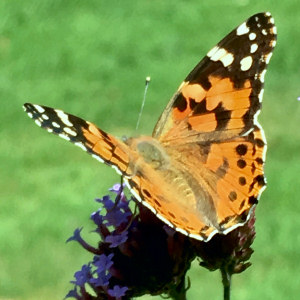 at up to 40 miles per hour.
They fly over high mountain ranges, and navigate by the
sun. Scientists have
done a lot of research into this phenomenon at Rothamsted, in
Harpenden. at up to 40 miles per hour.
They fly over high mountain ranges, and navigate by the
sun. Scientists have
done a lot of research into this phenomenon at Rothamsted, in
Harpenden.
Painted Ladies only live for 3 weeks.
They mate towards the end of their 3 week life span and
lay their eggs on a variety of plants including thistles and
nettles.
Why do they migrate so far?
In Morocco they have an enemy, a small parasitic wasp which lays
its eggs in the caterpillar and when the maggots hatch they eat
the caterpillar from the inside out.
Many Painted Lady caterpillars are attacked in this way.
At the Natural History Museum in London they have thousands of Painted
Ladies pinned in boxes and also a pressed one dating from the 16th
century.
Do look out for them in 2020.
The males are bigger than the females
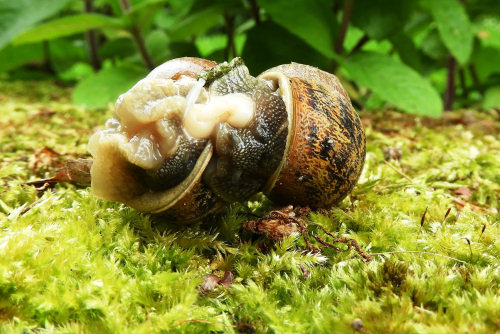 and more brightly
coloured. and more brightly
coloured.
The end of July was extremely hot.
38 degrees was recorded in Cambridge.
Given the dry weather we have not seen too many slugs and
snails although there are plenty around judging by the state of
some of my lettuces.
I managed to snap these two in the garden mating.
Snails are hermaphrodite so it must be easy to find a
mate!
|
|
September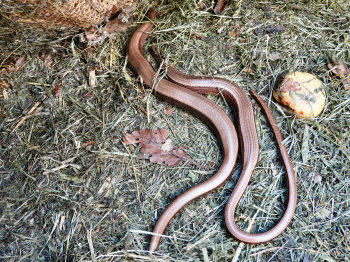
There has been a notable absence of slow worms this year.
There are usually plenty in the compost heaps but none
this year nor any grass snakes.
After the silence of the birds throughout the latter half of June and
July and August the robins are singing again and I’ve heard a
tawny owl in the evening.
It must be a female because it is a twit or keewit call.
It is the male who responds with a twoo or hoo-oo.
Unfortunately for her, call as she might no male is
responding.
|
|
October, November and December
The weather has become wet and miserable, and although we didn’t know it
when it started, it was to continue through most of November and
December. The fields
are sodden and on 8 November there was serious flooding in
Doncaster and East Yorkshire.
However, amidst all the doom and gloom the blossom and
the berries have been truly magnificent this year and the Autumn
colours are striking especially the yellows of hazel, field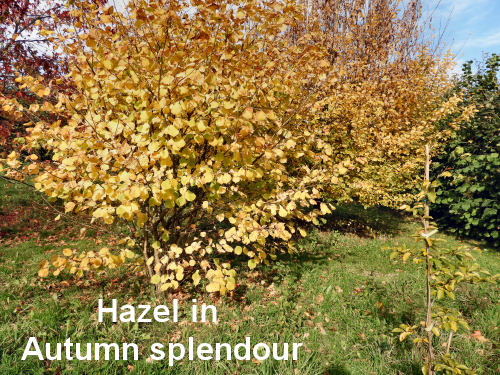 maple, ash, hornbeam and lime.
maple, ash, hornbeam and lime.
In November I went to hear Isabella Tree give an illustrated talk at the
Bridport Literary Festival on the rewilding experiment at Knepp
Farm in West Sussex. If you haven’t yet read her book “Wilding”
then I urge you to do so.
It is a bold experiment but based on scientific evidence,
and now they have so many species of birds, like turtle doves
and nightingales for example, which are highly endangered.
I have made no mention of butterflies in this diary apart from Painted
Ladies because we have a page all about butterflies on the
Winsham Web.
However, I will just mention that I recorded my last Red Admiral
of 2019 on 14 November.
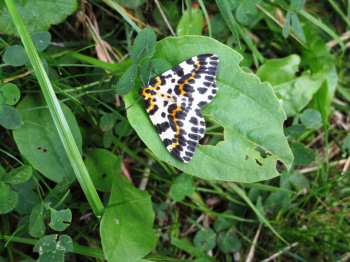
I will also mention what a beautiful day Christmas Day was – one of the
very few!
Finally, please can anyone identify this butterfly photographed near
Winsham?
|
Click HERE to return
to Main Fossil Index
|
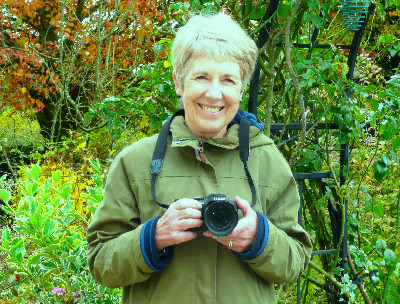




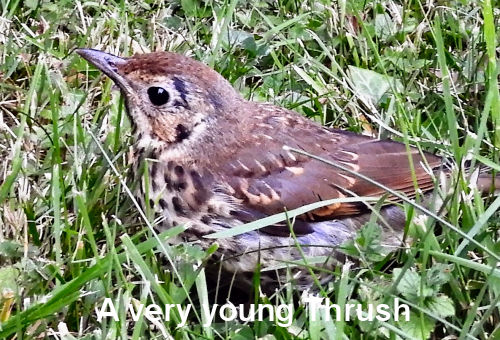
 at up to 40 miles per hour.
at up to 40 miles per hour. and more brightly
coloured.
and more brightly
coloured.
 maple, ash, hornbeam and lime.
maple, ash, hornbeam and lime.